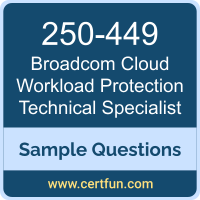 Getting knowledge of the Broadcom 250-449 exam structure and question format is vital in preparing for the Symantec Cloud Workload Protection - R1 Technical Specialist certification exam. Our Broadcom Cloud Workload Protection Technical Specialist sample questions offer you information regarding the question types and level of difficulty you will face in the real exam. The benefit of using these Broadcom 250-449 sample questions is that you will get to check your preparation level or enhance your knowledge by learning the unknown questions. You will also get a clear idea of the exam environment and exam pattern you will face in the actual exam with the Symantec Cloud Workload Protection - R1 Technical Specialist Sample Practice Test. Therefore, solve the Broadcom Cloud Workload Protection Technical Specialist sample questions to stay one step forward in grabbing the Broadcom Symantec Cloud Workload Protection - R1 Technical Specialist credential.
Getting knowledge of the Broadcom 250-449 exam structure and question format is vital in preparing for the Symantec Cloud Workload Protection - R1 Technical Specialist certification exam. Our Broadcom Cloud Workload Protection Technical Specialist sample questions offer you information regarding the question types and level of difficulty you will face in the real exam. The benefit of using these Broadcom 250-449 sample questions is that you will get to check your preparation level or enhance your knowledge by learning the unknown questions. You will also get a clear idea of the exam environment and exam pattern you will face in the actual exam with the Symantec Cloud Workload Protection - R1 Technical Specialist Sample Practice Test. Therefore, solve the Broadcom Cloud Workload Protection Technical Specialist sample questions to stay one step forward in grabbing the Broadcom Symantec Cloud Workload Protection - R1 Technical Specialist credential.
These Broadcom 250-449 sample questions are simple and basic questions similar to the actual Broadcom Cloud Workload Protection Technical Specialist questions. If you want to evaluate your preparation level, we suggest taking our Symantec Cloud Workload Protection - R1 Technical Specialist Premium Practice Test. You might face difficulties while solving the real-exam-like questions. But, you can work hard and build your confidence on the syllabus topics through unlimited practice attempts.
Broadcom 250-449 Sample Questions:
01. What is required to successfully complete a Cloud Workload Protection agent installation?
a) Delete the agent enrollment keys
b) Restart the instance
c) Remove the instance token
d) Re-deploy the instance
02. A network rule for the DNS service that is specified under the Windows OS and Modules sandbox allows inbound connections from all IP addresses on the DNS port. This connection is denied in the Global policy. Why does an inbound IP connection reach the protected instance?
a) The sandbox policy rules supersede the global policy rules
b) Given contradicting policy rules, allow is the default behavior
c) The global policy rules supersede the sandbox policy rules
d) The global denial will apply only if there are no contradicting sandbox-specific rules
03. Where can an administrator quickly see a count of software services and platforms that are exposed to any potential threats?
a) Threat Widget
b) Exposed Instance Events page
c) Threat Exposure Dashboard
d) Admin Notifications
04. How can an administrator segregate organizational data in a Cloud Workload Protection account?
a) With the use of additional Domains
b) With the use of Isolation Policies
c) With the use of Sandboxed Applications
d) With the use of License Separation
05. What is the name of the included command-line utility in Cloud Workload Protection for Storage?
a) API Index
b) Command Gateway
c) Command Module
d) Launch Pad
06. What is one use of the Windows Global Policy Agent Tools?
a) Allows Configuration Tools to run with full privileges for the root user.
b) Elevates privileges for all install agents.
c) Allows Configuration Tools to run with full privileges for specific users.
d) Removes agents from all Windows devices.
07. How quickly are assets scanned when using Near real-time scan for Storage?
a) Immediately after an object is added or updated
b) According to the schedule set in the global system policy
c) After system update and reboot
d) Every time the agent checks in for updates
08. Which control is used to configure an application policy for assignment to a target computer?
a) Policy commands
b) Policy options
c) Rules Wizard
d) Sandbox rules
09. Where are specific Domain Controller protection settings found in Cloud Workload Protection?
a) Global System Settings
b) Default OS Policy
c) Cloud Formation Template
d) The Windows OS Policy
10. What differentiates a Full Closed policy from a Full Open policy for a custom application?
a) The Full Open policy enforces maximum restriction, while the Full Closed policy does not offer restriction
b) The Full Closed policy cannot be tuned, while the Full Open policy allows for additional tuning.
c) The Full Closed policy enforces maximum restriction, while the Full Open policy does not offer restriction.
d) The Full Closed policy does not allow write access, while the Full Open policy allows for both read and write access.
Answers:
|
Question: 01 Answer: b |
Question: 02 Answer: d |
Question: 03 Answer: c |
Question: 04 Answer: a |
Question: 05 Answer: b |
|
Question: 06 Answer: c |
Question: 07 Answer: a |
Question: 08 Answer: b |
Question: 09 Answer: d |
Question: 10 Answer: c |
Note: For any error in Symantec Cloud Workload Protection - R1 Technical Specialist (250-449) certification exam sample questions, please update us by writing an email on feedback@certfun.com.
